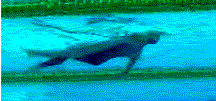HOW CHAMPIONS DO IT
Researched, produced, and prepared by Brent S. Rushall,
Ph.D., R.Psy.

NATALIE COUGHLIN AT 65 m OF HER GOLD MEDAL 100 m BACKSTROKE RACE AT THE 2004 ATHENS OLYMPIC GAMES
The time between each frame is not known. Natalie Coughlin's time for this race was 1:00.37. This series is displayed along with one at 20 m so that a better understanding of what happens with both arms during Ms. Coughlin's pull is obtained.
This stroke analysis includes a moving sequence in real time, a moving sequence where each frame is displayed for .5 of a second, and still frames.
The following image sequence is in real time. It will play through 10 times and then stop. To repeat the sequence, click the browser's "refresh" or "reload" button.

The following image sequence shows each frame for half a second. It will play through 10 times and then stop. To repeat the sequence, click the browser's "refresh" or "reload" button.

At the end of the following narrative, each frame is illustrated in detail in a sequential collage.
Notable Features
- The features described in Natalie Coughlin's stroke at 20 m are still evident at this stage of her race. The general descriptions from the 20-m analysis are repeated below.
- Natalie Coughlin's kick is not deep. That is a good feature particularly since recent research has shown that big kicks do increase propulsion but with a disproportionately greater increase in drag force. Another unusual feature is that Ms. Coughlin uses a four-beat kick rather than the "traditional" six-beat action.
- The swimmer rolls her total body to each side for each pull. That results in the pulling action being closer to the line of intended motion.
- Each arm action involves the total arm. The pull starts well behind the swimmer. Propulsion is directly backward with the three arm segments contributing to a coordinated propelling surface. The body roll cancels out the traditionally described "S-shaped" pull, resulting in a directly backward application of force. The mechanics of Ms. Coughlin's arm action are similar to a good crawl stroke action -- the arm is positioned for propulsion, and abduction followed by adduction provides the power. However, the arm extension is not similar to that of crawl stroke. Both arms finish with a very deep extension followed by a vigorous inward sculling action upward to extract the arm from the water.
- The swimmer's body angle has improved to about 15 degrees relative to the horizontal plane.

Return to Table of Contents for this section.






